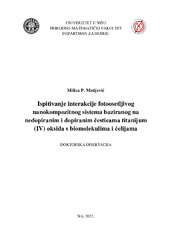Приказ основних података о дисертацији
Ispitivanje interakcije fotoosetljivog nanokompozitnog sistema baziranog na nedopiranim i dopiranim česticama titanijum (IV) oksida s biomolekulima i ćelijama
| dc.contributor.advisor | Đorđević, Dragan | |
| dc.contributor.other | Nakarada, Đura | |
| dc.contributor.other | Nešić, Maja | |
| dc.contributor.other | Korićanac, Lela | |
| dc.creator | Matijević, Milica | |
| dc.date.accessioned | 2023-02-15T20:35:29Z | |
| dc.date.available | 2023-02-15T20:35:29Z | |
| dc.date.issued | 2022 | |
| dc.identifier.uri | http://eteze.ni.ac.rs/application/showtheses?thesesId=8561 | |
| dc.identifier.uri | https://fedorani.ni.ac.rs/fedora/get/o:1836/bdef:Content/download | |
| dc.identifier.uri | https://plus.cobiss.net/cobiss/sr/sr/bib/69131785 | |
| dc.identifier.uri | https://nardus.mpn.gov.rs/handle/123456789/21174 | |
| dc.description.abstract | Nanostructured inorganic compounds such as TiO2 may be used as drug delivery carriers and photosensitizers (PSs) in light-based therapy – photodynamic therapy (PDT). This doctoral dissertation explores the implementation of PDT with unmodified TiO2 (colloidal nanoparticles, TiO2 NPs; prolate nanospheroids, TiO2 PNSs) and modified (doped nanoparticles, N- and C-TiO2 NPs; conjugated to a cytostatic model in the nanocomposite systems, NCSs). Transmission Electron Microscopy confirmed the nanosize (5-104 nm), whereas X-ray diffraction and Raman spectroscopy revealed predomination of the most photo-active form – anatase of the investigated TiO2. Afterwards, NCSs were formed by coordination of TiO2 NPs and PNS to the Ru(II) complex with cytostatic properties – cisdichlorobis( 2,2'-bipyridyl-4,4'-dicarboxylic acid) ruthenium(II). For the modified TiO2, UV-Vis spectroscopy and bandgap calculations confirmed the visible light absorption. Electron paramagnetic resonance spectroscopy revealed the presence of hydroxyl radical in water suspensions of TiO2 PNSs and C-TiO2 NPs, whereas no reactive oxygen species were detected in suspensions of TiO2 NPs and N-TiO2 NPs. For NCS, the long-term constant release profiles of the Ru(II) complex were established in vitro. Namely, the complex release at pH 7 induced by visible light was slower compared to UV and light’s absence. Furthermore, additional encapsulation of NCS in the small unilamellar vesicles significantly suppressed the complex release but with no lightinduced effect. Confocal microscopy revealed good cells’ internalization of the assessed TiO2. Viability tests on non-transformed cells upon the incubation with unmodified TiO2 indicated good biocompatibility. The photocytotoxic activity of the investigated TiO2 was tested on several cancer cell lines. The most significant viability reduction has been achieved by the combined treatment with C-TiO2 NPs and blue light on the HeLa cell line. Moreover, CTiO2 NPs promoted the programmed cells’ death mechanisms, contributing to their exceptional PS features for PDT. | en |
| dc.format | application/pdf | |
| dc.language | sr | |
| dc.publisher | Универзитет у Нишу, Природно-математички факултет | sr |
| dc.rights | openAccess | en |
| dc.rights.uri | https://creativecommons.org/licenses/by-nc-nd/4.0/ | |
| dc.source | Универзитет у Нишу | sr |
| dc.subject | Fotodinamička terapija | sr |
| dc.subject | Photodynamic therapy | en |
| dc.subject | ТiО2 | en |
| dc.subject | nanocomposite system | en |
| dc.subject | Ru(II) complex | en |
| dc.subject | band gap | en |
| dc.subject | ROS | en |
| dc.subject | photosensitizer | en |
| dc.subject | cytotoxicity | en |
| dc.subject | cell death modalities | en |
| dc.subject | ANOVA | en |
| dc.subject | TiO2 | sr |
| dc.subject | nanokompozitni sistem | sr |
| dc.subject | Ru(II) kompleks | sr |
| dc.subject | energetski procep | sr |
| dc.subject | reaktivne kiseonične vrste | sr |
| dc.subject | fotosenziter | sr |
| dc.subject | citotoksičnost | sr |
| dc.subject | vrste ćelijske smrti | sr |
| dc.subject | ANOVA | sr |
| dc.title | Ispitivanje interakcije fotoosetljivog nanokompozitnog sistema baziranog na nedopiranim i dopiranim česticama titanijum (IV) oksida s biomolekulima i ćelijama | sr |
| dc.type | doctoralThesis | |
| dc.rights.license | BY-NC-ND | |
| dc.identifier.fulltext | http://nardus.mpn.gov.rs/bitstream/id/149414/Matijevic_Milica.pdf | |
| dc.identifier.fulltext | http://nardus.mpn.gov.rs/bitstream/id/149413/Doctoral_thesis_13228.pdf | |
| dc.identifier.rcub | https://hdl.handle.net/21.15107/rcub_nardus_21174 |



